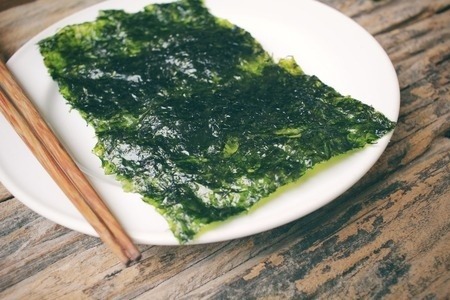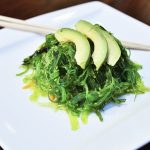
Fucoidan may help in the battle against cancer. Fucoidan as its name suggests is extracted from various brown seaweeds such as bladderwrack, wakame and hijiki. A few other marine invertebrates such as sea urchins and sea cucumber also contain fucoidans. Those names hint at the fact that brown seaweed has been consumed for centuries in the Far East but interest in fucoidan has only started to gather ground in recent years.
Chemical Structure
It is a sulphated complex polysaccharide (M.Wt. 20 kDaltons) of mostly fucose.
The main classification of natural fucoidan is based on chain type. The type I chain consists of α- (1 → 3)-linked fucose and type II chain consists of altering α-(1 → 3) and α (1 → 4)-linked fucose (Cumashi et al., 2007).
The sulphate content and molecular weight of fucoidan varies from algae species to another. The positions of the sulphate group too vary considerably and can be used to characterise each algal species or sub-species (Ale et al., 2011). The molecular weight (MW) and sulphate content of fucoidan from Ascophyllum nodosum for example with type II chain were 1330 kDa and 21.0%, but the MW and sulphate content of fucoidan from Laminaria japonica with type I chain was just 310 kDa and 18.4% (Shang et al., 2017).
We also know they can be characterised into two distinct forms: the F-fucoidan is over 95% sulphated esters of fucose and U-fucoidan is approximately 20% glucuronic acid. There are other types depending which species is selected and these types include other sugars such as D-galactose, D-mannose, D-xylose and uronic acid (Li et al., 2008).
Therapeutic Benefits Of Fucoidans
The fucoidans offer a wide range of benefits and diverse biological activities based on their structure. They have anti-inflammatory (Park et al., 2011), anticoagulant (Menshova et al., 2016), anti-virus (Senthilkumara et al., 2013), immunomodulating (Kim & Joo 2008), anti-cancer (Vishchuk et al., 2016) and anti-oxidative activities (Koh et al., 2019).
All research so far has all been ‘in vitro’ or in animal models. There are no high quality human trials yet to elucidate the therapeutic benefits in a real life situation. One interesting study looked at cancer cell death in a human colon cell line (Kim et al., 2010)
To obtain a claim might also rely of appropriate characterisation of the polysaccharide as studies are likely to come from mixed sources. One issue is that brown seaweed as with all seaweeds generally has relatively high levels of iodine which could exacerbate thyroid problems.
A series of reviews are available on this polysaccharide (Li et al., 2008; Holdt & Kraan, 2011).
References
Ale, M. T., Mikkelsen, J. D., & Meyer, A. S. (2011). Important determinants for fucoidan bioactivity: A critical review of structure-function relations and extraction methods for fucose-containing sulfated polysaccharides from brown seaweeds. Marine Drugs, 9(10), pp. 2106-2130 (Article).
Cumashi, A., Ushakova, N. A., Preobrazhenskaya, M. E., D’Incecco, A., Piccoli, A., Totani, L., … & Nifantiev, N. E. (2007). A comparative study of the anti-inflammatory, anticoagulant, antiangiogenic, and antiadhesive activities of nine different fucoidans from brown seaweeds. Glycobiology, 17(5), pp. 541-552 (Article).
Holdt, S. L., Kraan, S. (2011). Bioactive compounds in seaweed: functional food applications and legislation. J. Appl. Phycology, 23(3), pp. 543-597.
Kim, M. H., & Joo, H. G. (2008). Immunostimulatory effects of fucoidan on bone marrow-derived dendritic cells. Immunology letters, 115(2), pp. 138-143.
Kim, E. J., Park, S. Y., Lee, J. Y., & Park, J. H. (2010). Fucoidan present in brown algae induces apoptosis of human colon cancer cells. BMC gastroenterology, 10(1),pp. 96
Koh, H. S. A., Lu, J., & Zhou, W. (2019). Structure characterization and antioxidant activity of fucoidan isolated from Undaria pinnatifida grown in New Zealand. Carbohydrate Polymers, 212, pp. 178-185.
Li, B., Lu, F., Wei, X., & Zhao, R. (2008). Fucoidan: structure and bioactivity. Molecules, 13(8), pp. 1671-1695.
Menshova, R. V., Shevchenko, N. M., Imbs, T. I., Zvyagintseva, T. N., Malyarenko, O. S., Zaporoshets, T. S., … & Ermakova, S. P. (2016). Fucoidans from brown alga Fucus evanescens: Structure and biological activity. Frontiers in Marine Science, 3, 129
Senthilkumar, K., Manivasagan, P., Venkatesan, J., & Kim, S. K. (2013). Brown seaweed fucoidan: biological activity and apoptosis, growth signaling mechanism in cancer. International Journal of Biological Macromolecules, 60, pp. 366-374.
Shang, Q., Song, G., Zhang, M., Shi, J., Xu, C., Hao, J., … & Yu, G. (2017). Dietary fucoidan improves metabolic syndrome in association with increased Akkermansia population in the gut microbiota of high-fat diet-fed mice. Journal of Functional Foods, 28, pp. 138-146 (Article).
Vishchuk, O. S., Sun, H., Wang, Z., Ermakova, S. P., Xiao, J., Lu, T., … & Zhu, F. (2016). PDZ-binding kinase/T-LAK cell-originated protein kinase is a target of the fucoidan from brown alga Fucus evanescens in the prevention of EGF-induced neoplastic cell transformation and colon cancer growth. Oncotarget, 7(14), 18763.



Fucoidan is a wonderful natural extract. I am especially fond of Undaria Pinnatifida, or wakame seaweed, which I am sad to see that you do not mention. This particular seaweed is the most thoroughly researched and beneficial member of the fucoidan family.